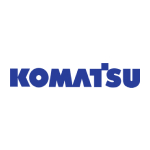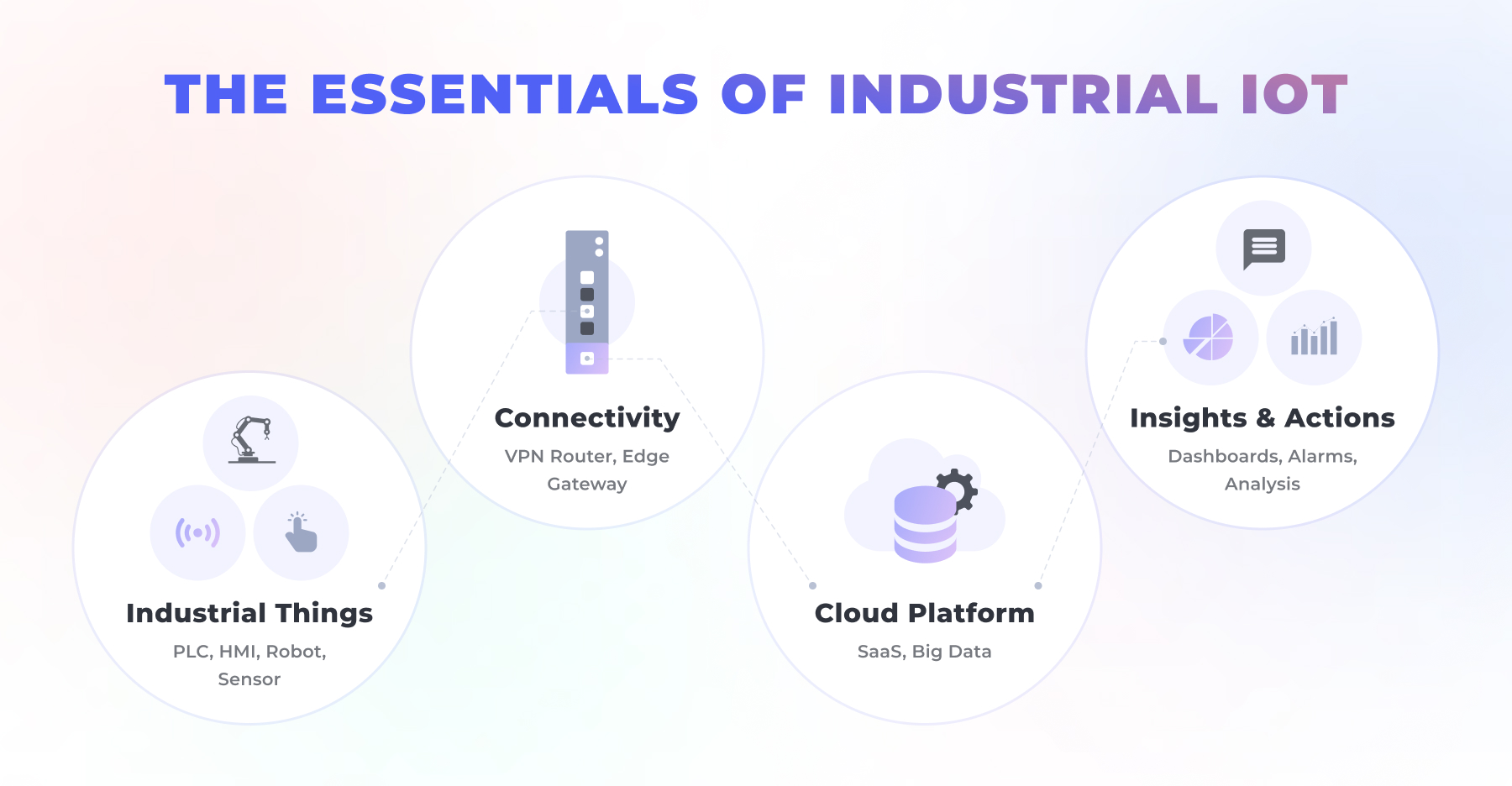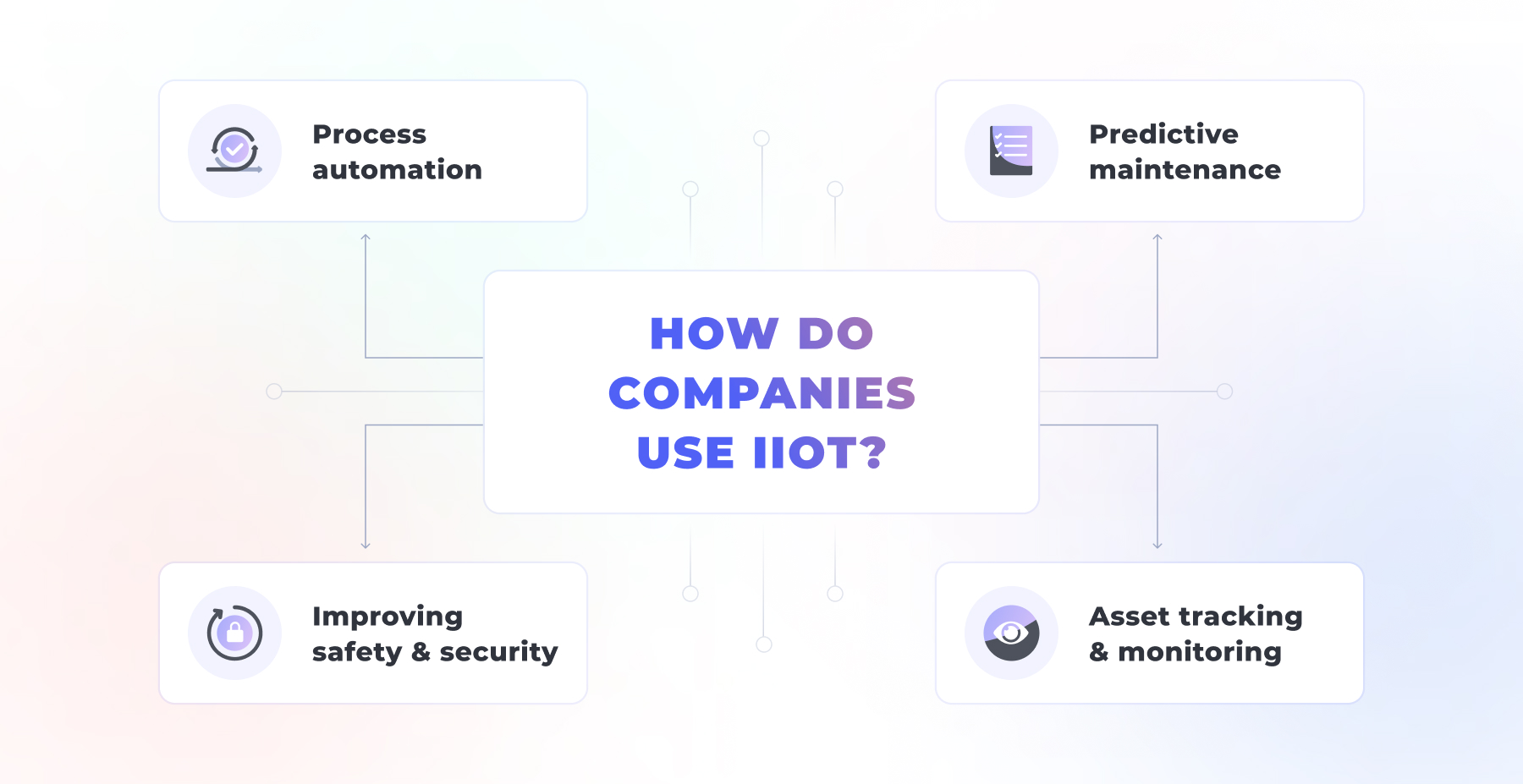Table of Contents
How should modern manufacturing look like? We all have seen movies or read books about the future where robots and machines run everything, including factories and plants. So, the question is: how soon will this fiction become reality, and will it ever be fully?
It might be a little presumptuous to assume that we are already living in the futuristic era where the industry is self-conscious and doesn’t need any human involvement whatsoever. However, nowadays, manufacturing is changing rapidly and turning into “Industry 4.0”.
There are numerous technologies the usage of which turns manufacturing for the better, but one of the main drivers that stands out and pushes it significantly further is the Industrial Internet of Things.
The Industrial Internet of Things, or IIoT, is a subdomain of the Internet of Things. In this case, connected “things” that underpin the whole concept of IoT are implemented into the manufacturing process.
Common IoT devices, like wearables or smart speakers, are designed to ease the everyday routine and bring new experiences to the customer. IIoT, on the other hand, pursues another goal, which is to optimize production, resource usage, and quality of goods.
IIoT consists of connected devices that monitor and collect data on the activity and state of equipment, and software that processes the data. Such connectivity created conditions for the next industrial revolution and led to the appearance of the term: “Industry 4.0”. This stage of manufacturing implies the automation of traditional industrial practices, machine-to-machine communication, diagnosis, and troubleshooting done by machines without human involvement.
Get to know more about the interesting topic – application of data mining in IoT and its role in the manufacturing industry in our blog article:
IIoT is applicable to many manufacturing sectors, for example, IoT automotive, electronics, aerospace, heavy industrials, oil, and gas. The value, importance, and impact of IIoT are hardly exaggerated, considering that it is a solution for:
- insufficient productivity;
- high rate of human errors that affect the quality or speed of production;
- breached secure measures;
- complex and resource-demanding maintenance of the equipment.
In this article, we will describe the practical aspects of IIoT development and implementation in your business and why every manufacturer needs connected devices to stay competitive in the market. So, let’s dive into the world of IIoT!
The IIoT market
IIoT is a fast-growing sector with more-than-decent prospects. As of 2021, the size of the market is estimated at USD 76.7 billion and expected to balloon to USD 106.1 billion by 2026 according to some. That makes for a 6.7 percent CAGR (compound annual growth rate).
Another, more optimistic report compiled by Grand View Research, Inc. predicts that the IIoT market will reach a whopping USD 1.11 trillion by 2028, implying a CAGR of 22.8%, which is a more-than-impressive growth rate despite inflation considerations.
The top three markets for IIoT are the Asia-Pacific region, North America, particularly the US, and Europe, with Germany in the lead trailblazer role on the continent. It is anticipated that Chinese, American, and Western European investment into IoT down the road will be growing at a CAGR of 13.4%, 9.0%, and 11.4% respectively.
Some of the most famous IoT hardware companies are Bosch, Cisco, Dell, Intel, and Lenovo.
COVID has slowed down the expansion of this market, but it is expected to continue its ascent higher in terms of influence on global business. According to Vodafone research, 84% of businesses that implemented IoT said that it had shown positive effects and even helped to overcome some challenges brought about by the pandemic. We can conclude that IoT technologies reconfirmed and proved once again their relevance for modern businesses. Leading to it being ever more in demand and providing an incentive and push for tech capabilities to be constantly improving and progressing.
Industrial IoT Use Cases
IoT devices connect the different parts of manufacturing, allowing easy data exchange between machines, platforms, and people. Constant connectivity opens the gate for various improvements in the flow of manufacturing processes. Here are some of them.
Process automation
IoT applications allow one to automatically gather huge amounts of data. This process previously fully depended on manual labor, which definitely took more time, and thus money. Moreover, smart sensors that are implemented in the equipment show higher accuracy and remove the likelihood of mistakes commonly made by humans.
IoT enables smart factories, and usually, it works the following way: sensors collect data and monitor machine utilization and production. In case of errors or when human involvement is needed, the system gives an alarm or automatically adjusts the equipment. Here are some examples of how it is used in different industries:
- in the energy sector, especially with renewable energy sources, strong winds can harm the solar equipment; IIoT solutions can monitor when the wind is damaging solar panels and send commands to readjust them to minimize the impact;
- in manufacturing, IoT can analyze the usage of energy and optimize it; Airbus, one of the leaders in the aerospace industry, states that in this way energy consumption could be reduced by 20 percent;
- again in manufacturing, it’s possible to optimize the supply chain: automobile manufacturer Magna Steyr established a system, which tracks the number of assets required for efficient work and automatically sends orders for replenishment.
Predictive maintenance
Equipment is a big part of every manufacturing process; there are types of manufacturing but the common theme is that they all require maintenance.
IoT-sensor can monitor the state of the equipment, notice the signs of degradation and alert the staff beforehand when the repair is needed. Instead of having sudden breakdowns, you can get relevant data, run a predictive analysis and plan your maintenance schedule ahead of time, allocate resources reasonably and keep the production going.
Predictive maintenance provides:
- reduction in maintenance cost, as the companies don’t need to resort to crisis management and actually have a chance to plan and optimize the maintenance;
- enhanced security, as the equipment is under constant monitoring and the likelihood of accidents during work decreases.
Asset tracking and monitoring
Asset tracking is a practice that can improve business performance, but people really don’t pay nearly enough attention to it.
The reason is that it’s a resourceful task. However, with IoT tracking, it became a whole lot easier. The company just needs to place sensors on their equipment, tools, raw materials, and final products. Asset tracking helps monitor things closely, which is especially useful for things like maritime shipping of goods. With the data easily accessible, companies may prevent possible damages during delivery, and shipping crews can adjust climate control of temperature-sensitive goods being shipped.
Improving safety and security
Apart from keeping tabs on equipment and its state, IoT can improve other aspects of manufacturing safety. Connected smart equipment may produce data for environment analysis that can help pinpoint areas of weakness. Whenever there is a danger looming, the system will alert facility managers.
Some specific use cases may be:
- remote access to equipment that can be dangerous with physical proximity;
- environmental sensors that will notify employees that they are approaching unsafe areas;
- integrated safety systems with emergency response buttons available for workers to sound the alarm.
Industrial IoT examples
A lot of industrial giants already embraced IIoT in their practice and came out satisfied with the results. Let’s look closely at their experience.
Caterpillar

IIoT is implemented there for predictive maintenance of the machines and fleet monitoring and management. But the company didn’t stop there, and is now producing products for customers that have built-in, integrated IIoT technology capabilities; — for example, their excavators are considerably easier to operate than are traditional ones.
Moreover, Caterpillar’s usage of IoT positively affects clients in that the equipment and machinery have superior utilization: for example, through predictive maintenance, the company managed to save over 600 thousand USD for a mining client of theirs, while another client from the industry stated that using Caterpillar’s autonomous vehicles increased their productivity by 20%.
Shell

The challenges the company faced during the implementation were the difficulty of the surface where the pipeline was situated, the ability to connect through long distances, and scalability. The final solutions, of course, handled these complications with grace.
Komatsu

Later, with the rise of cloud computing, the company chose Azure by Microsoft to store the data from machines, which allowed easier scaling up and adding more machines from worldwide branches to KOM-MICS.
Industrial IoT companies
An efficient IIoT ecosystem consists of different elements: hardware, networks, connectivity, platforms, and applications. We collected some top market players in mentioned niches to give you an image of the field.
Hardware is manifested in physical form through modules, sensors, and gateways. Innovative means in hardware widens the possibilities for the whole IoT ecosystem. One of the top companies here is Bosch, a German manufacturer that produces different types of sensors (dimension, displacement, and vibration sensors), video systems, and robots.
Connectivity is another important part of IoT. It provides a wireless connection between devices. Companies usually use low-power wide area networks, or LPWAN, as it is the most suitable radio band for IoT. Here the main players are telecommunications companies like Verizon, Vodafone, and AT&T. The latter made a deal with IIoT platform Howden Uptime to provide global connectivity for better secure cloud solutions.
Other big companies with involvement that are worth mentioning are Microsoft, IBM, Cisco, and Intel. Along with Bosch which we already mentioned, these companies offer a wide range of products and services, from networks (cellular, Wi-Fi, Ethernet) to cybersecurity solutions.
Benefits of IIoT
IIoT has a wide range of possible applications, a number of which have already proven their worth through positive impact on businesses. The main but not the only advantage is improved overall effectiveness and performance.
Increased efficiency
It is the features that bring a real change: with lots of processes automated, manufacturing becomes quicker but products still retain a high level of quality. When IoT is used to monitor machine utilization, it increases productivity by 10 to 25%. Data collected by IoT devices can also bring up to 20% higher product count from the same product line.
New business opportunities
Access to data on the manufacturing process may bring a whole new point of view on how the company should work. IoT sensors and suitable algorithms can analyze the performance of your equipment and machines, electricity and water usage, supply chain efficiency, and so on. New insight can show you ways to cut spending or find new revenue streams.
Increased goods quality
IoT sensors allow detecting damage and defects on the assembly line. This way, it is easier to address the problem before the product goes to the market. Automation also decreases human involvement, hence the likelihood of errors decreases too.
Optimized costs
Considering the aforesaid, IIoT significantly changes and shapes how modern factories evolve. The decisions become predictive instead of reactive, the number of chaotic actions decreases, and the approach switches to being wholly data-driven. All of this leads to more reasonable spending and budget allocation.
ROI of IIoT
IIoT can bring many benefits, but what about the actual financial impact of the Industrial Internet of Things on the business? Without specific numbers, the whole implementation will be in vain and done only for the sake of technology.
To prove the profitability of the investment in IIoT, we suggest you use the ROI calculator and get data you may operate. However, to generate a relevant index, you need a clear understanding of how IIoT will be applied and how it will affect the following aspects:
- equipment maintenance and amount of downtime hours;
- what business processes will be automated and streamlined;
- what indicators (costs, time-to-market, etc.) will change and how;
- how labor compensation will change.
So, here is an important conclusion: IIoT implementation isn’t only a one-time project that concerns technical implementation. It should be approached as a global change in business processes and start with a problem. You need to ask all stakeholders: what problem do we want to solve with IIoT?
Starting from this point, you will be bound to create a strategy and research every step. This will lead to deliberate decisions and precise goals. Eventually, your IIoT implementation will have real value that can be measured in ROI and thousands of dollars saved.
Main Risks Associated with IIoT
The Industrial Internet of Things is the future, but it still creates new challenges for companies even with all positive sides. Here are some major of them.
IIoT demands notable investments
Adopting IIoT requires huge expenses: hardware, software, providing connectivity, maintenance, etc. The market offers solutions in various price ranges, but either way, the investment still would be quite significant.
But clear goals and strategy can mitigate this concern, especially if you need to justify the IIoT adoption to board members or C-level executives. With the right implementation approach, IIoT will pay off and have a decent ROI, and this may be your final decisive argument.
Constant connectivity
IIoT requires a strong connection. Connectivity outages are a big issue for smart factories, which may lead to severe consequences. Firstly, it may cause downtime of devices and block production which leads to financial losses. Secondly, it also may cause safety concerns, especially if the factory uses IIoT sensors to control dangerous equipment or monitor hazardous zones.
The challenge here is finding a reliable vendor that can satisfy all of your requirements, ensure connectivity of every required location and provide minimum downtime.
Compatibility of legacy and IIoT infrastructure
IT/OT convergence is a great challenge for manufacturers. OT is usually slow to adapt, so they are already outdated and not fully compatible with new technologies like IIoT. At the same time, factories won’t replace legacy systems due to financial reasons only.
So, the goal of IT specialists and vendors here is to create migration strategies that won’t interrupt production and ensure the integration of all systems.
IoT skill gap
Even though IoT is a fast-growing domain, there is still a lack of competent specialists. This gap in knowledge may create some challenges for you, especially if it’s the first encounter with IoT for your in-house IT team.
Hence, finding a reliable IT vendor is crucial for successful IoT implementation. Consider involving external resources to cover the need for this specific expertise.
Safety and security concerns with IIoT
Despite all the positives, IIoT has a huge weakness, which is susceptibility to cyberattacks. Industrial IoT devices aren’t usually created with cybersecurity being a priority, but any manufacturer should guarantee protection from the threat of outside interference.
The more responsibility IoT devices gain, the more damage to the factory may be done in such an event. If production is automatically controlled and depends entirely on data from the IoT sensor, hackers’ interference may spoil your products or wreck the equipment. Compromised devices may also not give accurate and reliable info on the state of equipment, which may lead to machines unknowingly going out of order and becoming inoperable and ultimately leading to accidents that could have been avoided with the right safety and security measures.
The possible threats are:
- device hijacking, when malware takes over the control of the device and hides the fact of a takeover;
- data siphoning, when the hacker can get access to the data transferred through Industrial IoT devices;
- data breaches, when the attacker reaches the central network with sensitive data;
- device spoofing, when the attacker interferes between the IoT device and networks or cloud and sends the compromised data, while the system identifies them as a functioning device;
- denial of service attack, when the hacker spams the devices with so much traffic that they can’t function correctly.
To avoid cyberattacks and ensure the security of IIoT environments, manufacturers should:
- establish regular IIoT maintenance;
- implement the risk assessment modules;
- follow encryption standards;
- monitor and log every event done by the devices.
IIoT licenses, protocols, and standards are also an important part of security and safety. There are two main types of protocols: IoT data protocols (MQTT, CoAP, AMQP, DDS, HTTP, WeebSocket) and network protocols (Wi-Fi, Bluetooth, ZigBee, Z-Wave, LoRaWan). IEEE Standards Association also created a list of required protocols for IoT.
Want to save this information? Download our PDF report on IIoT.
IIoT and Integration with Other Technologies
The potential of IIoT is great, but it generates enormous value while being integrated with other technologies and pieces of software. Using such a combination, the company gets an opportunity to reach a higher level of automation.
Enterprise Resource Planning System
ERPs have all rights to be named legacy systems, however, they are still in demand by manufacturers. ERP software connects the whole company, and collects valuable data but still has its own drawbacks (especially old-school, on-premise systems).
However, IIoT can cover these gaps and improve ERP performance. For example, it affects master data significantly. This information includes production orders, material types, good issues and receipts, planning requirements. Previously, this data was once stored in the system and that’s all. Now, IIoT allows constant synchronization, and hence, a realistic representation of operations.
Moreover, IIoT will give greater visibility and tracking for every part of products. This will positively affect the supply chain, shipping, product recalls, and even customer services.
Integrating your ERP with IIoT is a good occasion to move the system to the cloud. Cloud ERP solutions demand less maintenance, they can be accessed remotely, and they grant you more agility which is definitely a necessary feature right now.
Artificial Intelligence
AI is another trend in the field of smart manufacturing, and it’s no wonder! Artificial intelligence and machine learning algorithms use the data that is generated by IIoT sensors to self-manage operation processes.
The biggest benefit here is the fact that human involvement isn’t necessary here. AI proceeds, analyses, implements data, and makes operational decisions. For the big factories where the volume of data is too big for manual processing, AI relieves a great amount of pressure and human effort.
Top IoT Conferences 2022
Want to learn the best use cases and examples of successful IIoT development and implementation? We gathered top events that will happen next year with top speakers from Microsoft, Samsung, Bosch, and leading research institutes.
- Industrial IoT Conference, February 8-11, 2022, Fort Lauderdale, FL, US
- Embedded IoT World, April 28-29, 2022, TBA
- IoT Solutions World Congress, May 10-12, 2022, Barcelona, Spain
- The World AI IoT Congress 2022, June, 6-8, 2022, Seattle, US
- IoT Week, June 20-23, 2022, Dublin, Ireland
Why choose Altamira for IIoT development
Software is an important part of any IIoT system that powers devices and makes the connection functional and useful. Altamira offers IoT development for manufacturers in different industries.
We offer:
- IoT and IIoT software development and testing on real devices;
- IoT integration with AI and ML;
- manufacturing ERP development from scratch and ERP integration with IIoT;
- upgrading of your legacy manufacturing solutions.
As a software development company, we provide you with:
In conclusion
Manufacturing is rapidly changing, embracing new and innovative technologies. Manual, routine labor can’t compete with automated machines — standardized, smart manufacturing not only increases productivity but also ensures product quality, improves employee safety, and optimizes costs.
The Industrial Internet of Things is one of the main technologies that make Industry 4.0 possible. With the constant capacity to monitor any process, it changes the paradigm of the manufacturing operation, making the predictive approach the new standard.
IIoT is the future of any factory. The manufacturers who look for how to improve their performance should consider the implementation of IoT technologies, as it’s already proven to be an efficient way in which world-leading organizations innovate and modernize to continue being cutting-edge.





